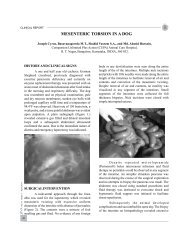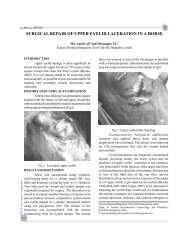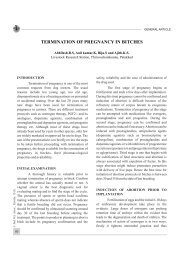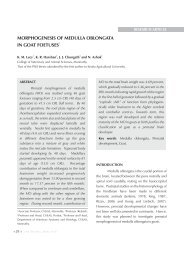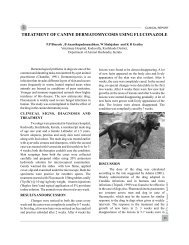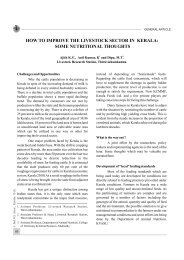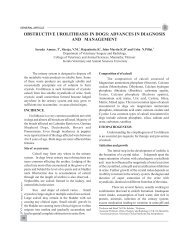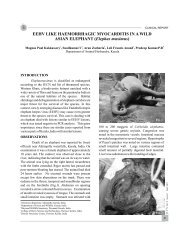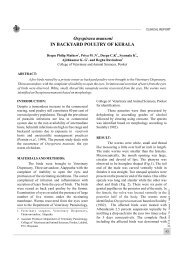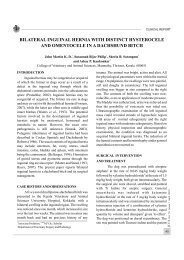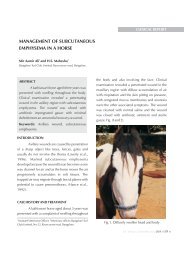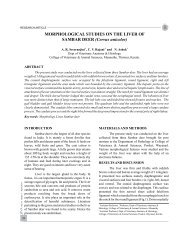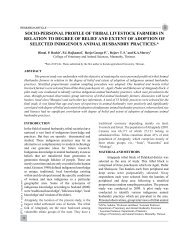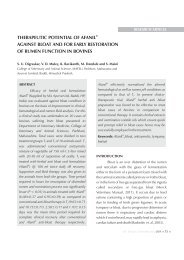2012 Jiva April Cover 220 GSM Art Card Glossy ... - Jivaonline.net
2012 Jiva April Cover 220 GSM Art Card Glossy ... - Jivaonline.net
2012 Jiva April Cover 220 GSM Art Card Glossy ... - Jivaonline.net
You also want an ePaper? Increase the reach of your titles
YUMPU automatically turns print PDFs into web optimized ePapers that Google loves.
RESEARCH ARTICLEJ. Ind. Vet. Assoc., Kerala. 10 (1)juiciness, and tenderness (Pearson et al., 1987). Thedifferent strategies for developing low fat meat andmeat products include modification of carcasscomposition, manipulation of meat raw materialsand reformulation of meat products. Maintenance ofacceptable palatability must remain an importantconsideration in any effort to reduce fat in meatproducts. So manufacturing further processed meatproducts with beef cuts with excess fat trimmed offand by reformulation with nonmeat and fat replaceringredients provide greatest opportunity to reduce fatand the problems encountered with the reduction offat (Colmenero et al.,2001). Carbohydrate based fatreplacers are probably the most widely used class ofreplacers in low fat meat product manufacture(Shand et al., 1990). These achieve fat replacementby stabilizing the added water in a gel-like matrix,resulting in lubricity and moisture release similar tohigher fat products (Glicksman, 1991). Skog et al.(1992) reported that adding both starch and glucoseto the beef patties inhibited mutagenic activity by upto 54 percent. Processed starches like plain flour,rice starch, modified potato, and tapioca are commonin meat formulations. Therefore, the present studywas aimed at developing a low fat lean beef loafutilizing lean beef cut after trimming excess fat, plainflour and other non-meat ingredients and to assess itsproximate composition, yield, nutritional value andsensory qualities.MATERIALS AND METHODSLean beef loaf development and formulationLean meat from a bull hygienicallyslaughtered and dressed in the Department ofLivestock Products Technology, College ofVeterinary & Animal Sciences, Mannuthy wasutilized for the study. The meat, after removal ofall visible fat, blood clots, tendons and visibleconnective tissue, was coarsely ground throughkidney plate and a 9mm plate in a meat mincer(MADO Primus Model MEW 613, Germany). Allthe non-meat ingredients were taken on ground leanmeat weight basis (Table 1).Table 1.Lean beef loaf formulation.(AMSA, 1983).IngredientsLevel ofaddition (percent)Extra lean beef 65Plain flour 8Water (g) 13Salt (g) 1.3Sugar (g) 2Sodium nitrite (ppm) 85Sodium ascorbate (ppm) 500Chopped onion, Garlic pasteand Ginger paste 1.4Black pepper, Anise,Cinnamon, Red Chillypowder and Turmeric powder 4beef tallow 5.5The raw spices like black pepper, anise,cinnamon, red chilly and turmeric were freshlyground just before use. Onion, ginger and garlicwere made into a paste. Minced meat was then mixedwith salt, sugar, sodium nitrite and sodium ascorbatedissolved in chilled water, plain flour, ground spices,chopped onion, ginger and garlic paste using a handheld mixer into a uniform batter. This was tumbledin a double drum vacuum tumbler (BIRO ModelVTS43, Germany) for 1 h (15 min. on and 5 min. off)at 7 rpm and 20” of Hg. The tumbled mix was thenstuffed into stainless steel loaf pan and cooked in aoconvection oven to an internal temperature of 85 C,ochilled to 1- 4 C and sliced. The loaf was thenanalysed for its proximate composition (AOAC,1990). Total calories and calories from fat, proteinand carbohydrate were determined as per FAO(2002). Per cent RDA (Recommended DailyAllowance) for calories from fat, protein, andcarbohydrate was calculated based on a <strong>220</strong>0 kcaldiet (ICMR, 1990). Per cent daily value of nutrientin the loaf was calculated as per cent nutrient in theloaf divided by RDA of the nutrient. RDA of proteinwas taken as 60g (ICMR, 1990). Cooking yield28



